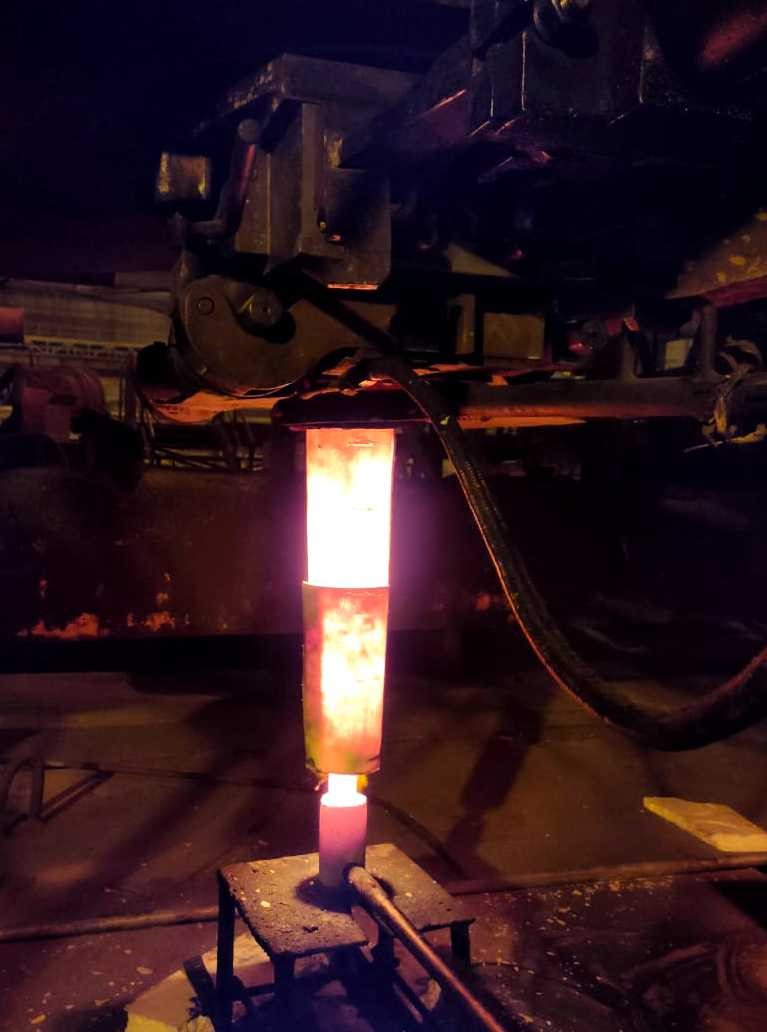Submerged entry nozzles are effectively used as a nozzle to transfer metal from the tundish to a particular strand. The primary function of SEN is to prevent reoxidation and heat loss from steel. Some other functions are providing unbiased flow in the mold, enhance the flotation of inclusions to the mold which can get trapped into the top slag, providing optimum heat to the surface of the meniscus for proper melting of mold powder and also to the corners for prevent chilling, minimize mold level surface turbulence which can otherwise vortex mold powder down into the product. Optimal design is required when looking to produce ULC and D&I products. Many variables like bore diameter, port shape and size, outer shape, number of ports, bottom shape, submergence depth and argon flow etc. influences the flow pattern, surface velocity in the mold as well as the powder consumption and SEN life.
Analysis
Thermal
Peak Temperature: Being in direct contact with steel, the temperature of the lining is that of the steel.High temperature resistant materials are to be used.
Thermal Shock: The thermal cycling for the working lining is less. Thermal shock takes place when the preheated SEN moves from the preheating position to the casting position. The delay in start of casting cools down the SEN even further (Delay more than 5minutes can cause severe thermal shock. The temperature drop observed for 5 minutes of cooling time is around 150-200 deg C). The SEN are very sensitive to the heating cycles and should be rejected if not used after preheating. The preheating cycle is to be strightly followed for getting higher life. Vertical crack results from a thermal shock due to thermal induced tensions.
Mechanical
Impact: The impact from the steel is less which cannot be considered a key wear mechanism. Rough SEN change can result in generation of higher level of torque stress at the SEN flange. Steel can reinforcement are used nowadays to support the refractory. Although flange cracks can even result incase of rough SEN which can cause air aspiration.However, some impact can take place for inclined SEN.
Abrasion:The abrasion of the SEN is dependent on the throughput rate of steel flow and the bore diameter. In case of too large bore diameter clogging buildup will take due to stagnant boundary layer resulting from low velocity metal flow where as insufficient metal flow will take place in case of very small bore diameter and becomes difficult to compensate when clogging takes place.
In case of tube changer special care is to be taken for design of sliding surface at the top of the SEN. Severe erosion can result in formation of fins which can interrupt SEN change. Therefore, better and stronger materials are desired. Thus abrasion is big factor in these type of cases.
Applied stress: The applied stress are only because of the presence of SEN holder which restricts the growth of SEN. Apart from that there is no restriction during its expansion and contraction period.
Chemical
Dissolution:Wear by dissolution depends on the chemical compatibility of the slags with the refractory. The slag line area suffers from erosion from the mold powder slag. The slag erosion is very aggressive as the mold powder is meant to be low melting ceramics responsible for the lubrication of solidified shell. The low melting ceramics dissolve and penetrate the refractory which leads to rapid wear. Generally higher amount of carbon and zirconia is used to combat this phenomenon.Fluorine in mold powder increases the wear and thus fluorine free powder has been found successful in reducing the erosion rates. The present mold powder has higher viscosity which further reduces the erosion.
Penetration:Penetration is caused by low viscosity metal/ slag or highly wetting metal/slag penetrating into porous refractories.The low melting refractory used to lubricate the shell causes severe wear of the SEN by dissolving and penetrating deep into the refractory.
Thermo- Mechanical
Strain of thermal expansion-The applied stress are only because of the presence ofSEN holder which restricts the growth of SEN. Apart from that there is no restriction during its expansion and contraction period.
Chemical Mechanical and thermo mechanical chemical
Spalling of the penetrated zones- The spalling can take place due to cumulative action of abrasion, corrosion from mold slag and thermal cycling which can result in low life of the submerged entry nozzle.
Choice of material
The material normally used are alumna carbon mix containing 20-25% carbon (94% graphite) and 70-75% alumina (tabular, fused alumina with mullite additions) and slag line and the ports may contain 0-5% zirconia with 25% C. Exotic zirconia may be used (fused alumina or fused lime zirconia). The body is normally alumina carbon with no zirconia.
Al,Si is added as an antioxidant to protect the carbon.The top area is an high wear area and usually contains less carbon and lower zirconia.
Interior liner of low silica or carbon or high free lime may be used in order to prevent buildups.
(Note: Alumina build up due to the air entrapment is to be minimized. Oxygen present in the air reacts with the Al in the steel leading to the formation of alumina inclusions. However refractory can even contribute to the formation of inclusions. Presence of gases like CO at high temperature oxidizes the Al. Argon gas is injected through ports on the top and bottom slide gate plates to prevent air infiltration).
© Metal world insight



